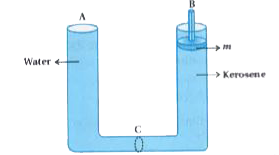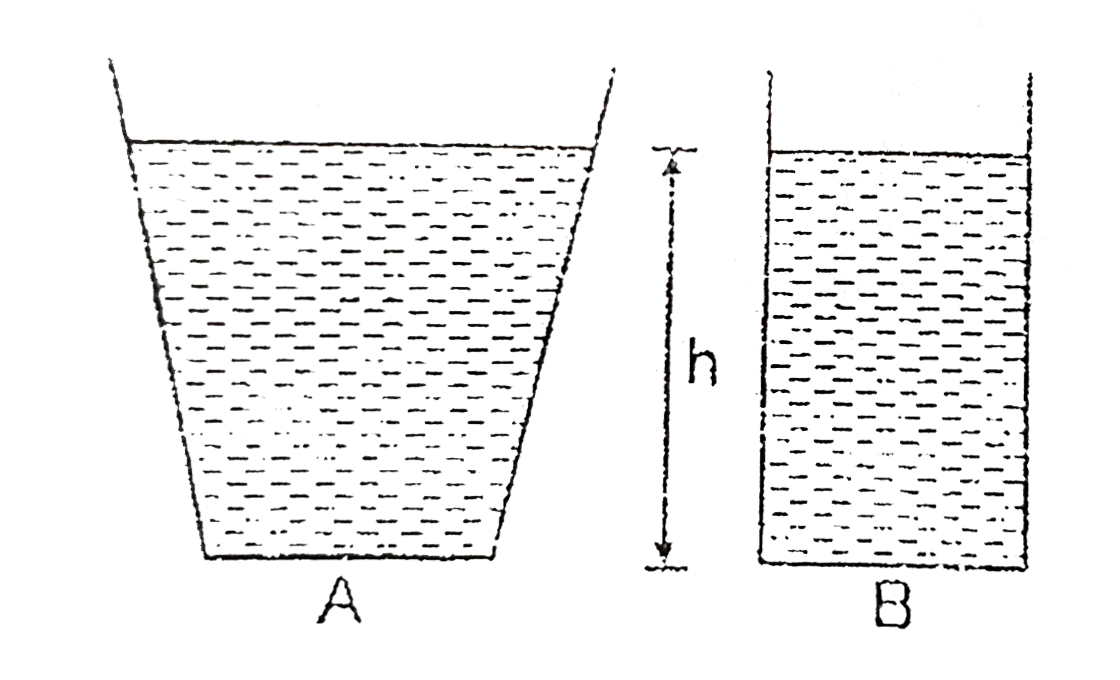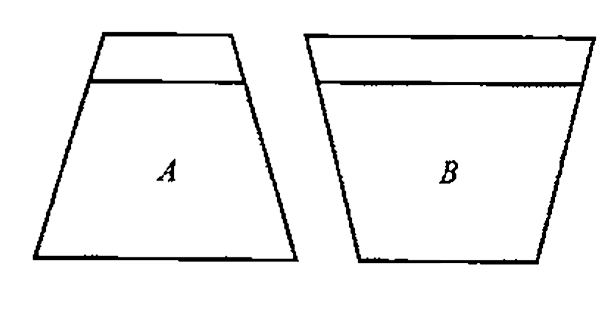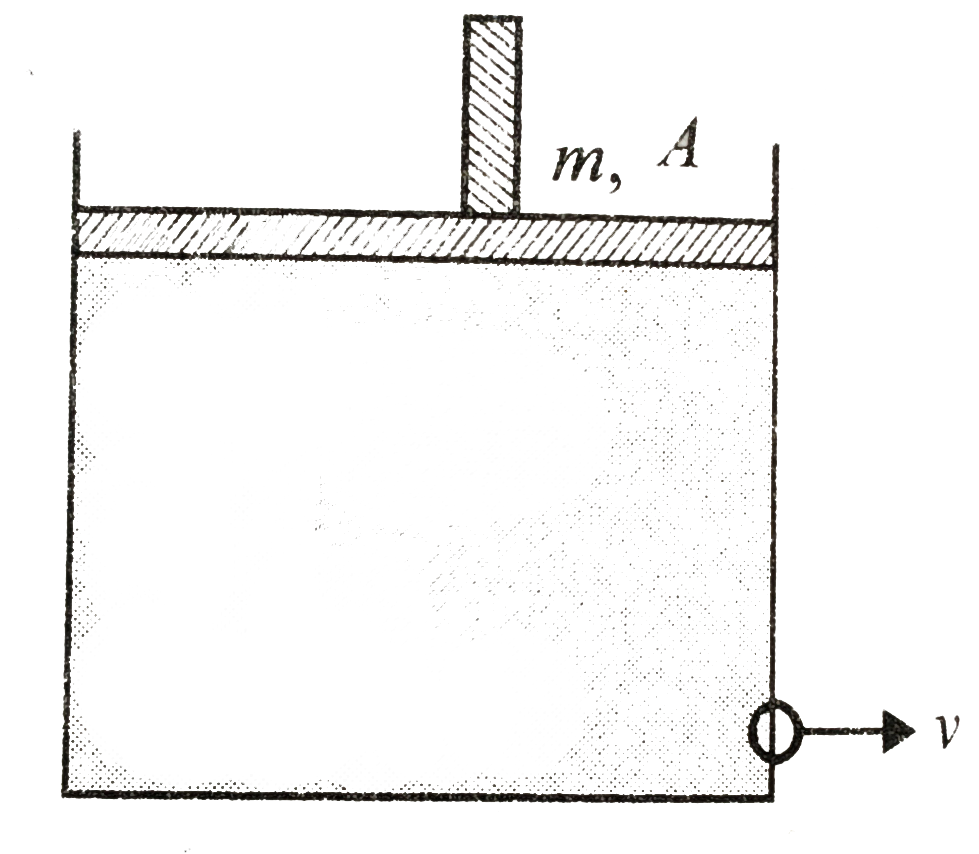As shown in the figure two cylindrical vessels A and B are interconnected . Vessel A contains water up to 2m height and vessel B contains kerosene . Liquids are separated by movable, airtight disc C . If height of kerosene is to be maintained at 2m , calculate the mass to be placed on the piston kept in vessel B. Also calulate the force acting on disc C due to this mass. Area of piston =100cm2, area of disc
C=10cm2 , Density of water =103kgm−3, specific density of kerosene =0.8.
 Solution in Gujrati
Solution in Gujrati
Area of piston A1=100cm2=10−2m2
Area of disc A2=10cm2=103m2
Density of water ρw=103kgm−3
∴ Specific density of kerosene
=Density of keroseneDensity of water
=0.8
∴ Density of kerosene ρk
=0.8× density of water
=0.8×103
=800kgm−3
If height of kerosene is maintained at 2m ,
Pressure of water column =mgA1+ Pressure of kerosene column.
∴hρwg=hρkg+mgA1
∴2×103=2×800+m10−2
∴2000−1600=m10−2
∴m=400×10−2
∴m=4kg
Now pressure due to mass m is transmitted undiminished to disc C . So, pressure due to 4kg mass
=Force on disc CArea of disc C
∴mgA1=FCA2
∴FC=mg(A2A1)=4×9.8×(10−310−2)
FC=3.92N
Topper's Solved these Questions
- MECHANICAL PROPERTIES OF FLUIDS BOOK - KUMAR PRAKASHANCHAPTER - MECHANICAL PROPERTIES OF FLUIDS EXERCISE - SECTION -C (Objective Questions) (VSQs)
100 Videos
- MECHANICAL PROPERTIES OF FLUIDS BOOK - KUMAR PRAKASHANCHAPTER - MECHANICAL PROPERTIES OF FLUIDS EXERCISE - SECTION -C (Objective Questions) (VSQs) Fill in the Blank
9 Videos
- MECHANICAL PROPERTIES OF FLUIDS BOOK - KUMAR PRAKASHANCHAPTER - MECHANICAL PROPERTIES OF FLUIDS EXERCISE - SECTION - B Numerical From Textual Exercise
44 Videos
- MACHANICAL PROPERTIES OF SOLIDS BOOK - KUMAR PRAKASHANCHAPTER - MACHANICAL PROPERTIES OF SOLIDS EXERCISE - QUESTION PAPER
11 Videos
- MOTION IN A STRAIGHT LINE BOOK - KUMAR PRAKASHANCHAPTER - MOTION IN A STRAIGHT LINE EXERCISE - QUESTION PAPER
11 Videos
Similar Questions
Bag and suitcase have broad (wide) handle why ?
View SolutionAngle of contact increases with rising temperature of liquid .
View SolutionExplain why
(a) The blood pressure in humans is greater at the feet than at the brain.
View SolutionWhat is called brittle material ?
View SolutionDefine frame of reference and give its types.
View SolutionTwo vessels A and B have same base area. Equal volumes of a liquid are poured in the two vessel to difference heights hA and hB(>hA. In which vessel, the force on the base of vessel will be more?
View SolutionA cylindrical vessel contains a liquid of density rho up to height h . The liquid is closed by a piston of mass m and area of cross section A . There is a small hole at the bottom of the vessel. The speed v with which the liquid comes out of the hole is
View SolutionTwo vessels A and B of different shapes have the same base area and are filled with water up to the same height h (see figure). The force exerted by water on the base is FA for vessel A and FB for vessel B. The respective weights of the water filled in vessels are WA and WB. Then

View SolutionTwo cylindrical vessels of equal cross-sectional area. A contain water upto height h1 and h2. The vessels are interconnected so that the levels in them becomes equal. The work done by the force of gravity during the process is:
View SolutionTwo vessels A and B of cross sections as shown contain a liquid up to the same height. As the temperature rises, the liquid pressure at the bottom (neglecting expansion of the vessels ) will :

View SolutionA cylindrical vessel contains a liquid of density ρ up to height h. The liquid is closed by a piston of mass m and area of cross section A. There is a small hole at the bottom of the vessel. The speed v with which the liquid comes out of the hole is

View SolutionThree vessels A,B,and C of different shapes contain a water upto the same height as shown in the figure . P_(A) ,P_(B) ,and P_(C) be the pressure exerted by the water at the bottom of the vessels A ,B and C respectively . Then
View SolutionTwo vessels A and B are filled with water at 4^(@)C .Vessel A is heated and vessel B is cooled.Then water overflows in
View SolutionTo what height should a cylindrical vessel be filled with a homogeneous liquid such that the force exerted by the liquid on the wall of the vessel be equal to the force exerted by the liquid on the bottom of the vessel?
View SolutionThe diameter and height of a narrow cylindrical vessel are 10 cm and 15 cm respectively. The vessel contains 200cm3 of water and the mass of the vessel is 114 g. The vessel is then placed inside a large vessel and water is poured into it. For what maximum level-height of water in the large vessel, will the cylindrical vessel just float up?
View Solution
